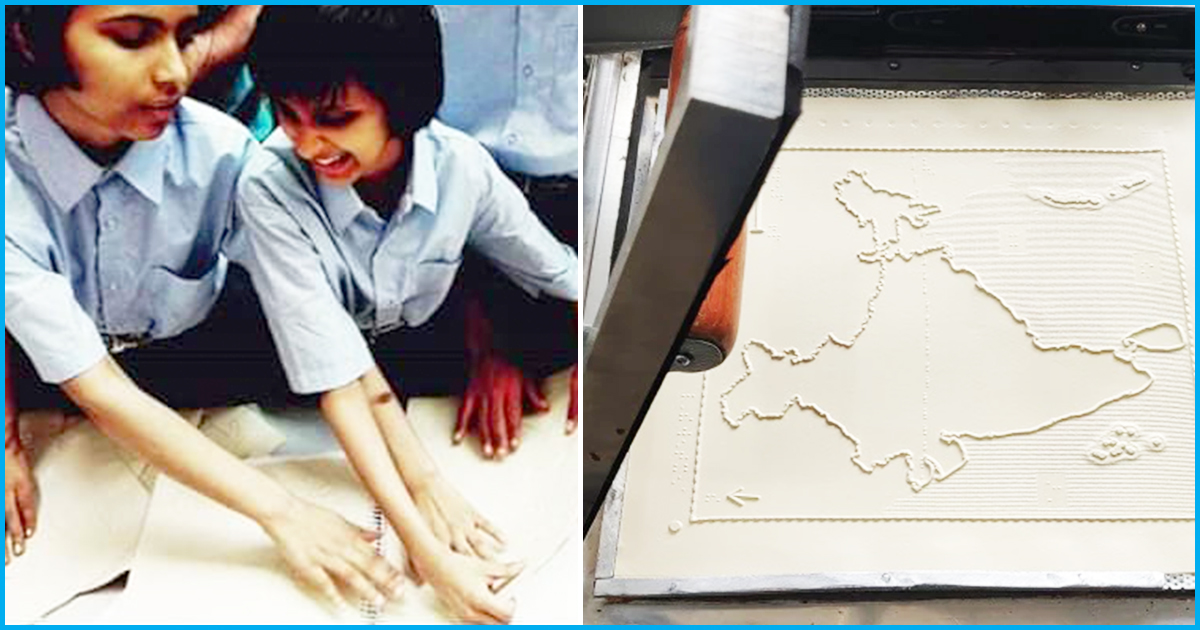
This Foundation Along With IIT Delhi, Produces Tactile Diagrams & Textbooks For Visually-Impaired Students
14 Feb 2019 4:37 AM GMT
Editor : Ankita Singh
A literature lover who likes delving deeper into a wide range of societal issues and expresses her opinions about the same. Keeps looking for best-read recommendations while enjoying her coffee and tea.
Of the entire population of visually impaired people present throughout the world, India contributes to the largest number of blind people. A very significant fraction of this population includes children in the age group of 5 to 19. Amid all the issues surrounding the visually- impaired people, one of the most important aspects that is usually ignored is the problem faced in learning. Learning subjects that require the use of diagrams, graphs such as mathematics, geography or science was difficult for them.
Considering all these problems faced by learners with visual impairment, Raised Lines Foundation was incubated after four years of research undertaken at Centre of Excellence (CoE) in Tactile Graphics, at IIT Delhi, sponsored by Ministry of Electronics and Information Technology, (MeitY) Government of India. The main mission of this foundation is to provide access to the textbooks along with the tactile diagrams to every student with visual impairment and empower them to choose subjects by choice and not compulsion.

Incubation of Raised Lines Foundation
Can you imagine studying in a mathematics class without the use of geometrical shapes or a geography class without using maps? Learning science, technology, engineering and mathematics (STEM) subjects without using graphs, diagrams and other drawings or representations is one of the major challenges faced by students who are blind or suffer from visual impairment of any kind. This often forces them to even choose subjects out of compulsion which they might not wish to pursue.
Helping such students to study sciences and other-allied subjects, Raised Lines Foundation has developed a technology, where, by using 3-D printing, tactile diagrams could be produced in a cost-effective and affordable way. The main aim behind this initiative is to enable learning to the visually-impaired students where they would be freedom to opt for their subject of choice rather than being forced to study theory based subject. This would even open new areas of learning and other opportunities for them.

Speaking with The Logical Indian, one of the research team members, Pulkit Sapra shares, “While working with NGOs and other organizations for the blind, we observed that most of these students were being taught using theoretical textbooks. Most of the Braille textbooks lacked diagrams and it was even difficult for the teachers to explain concepts related to maps, graphs to them. Introduction of low-cost Tactile Graphics will create a noticeable improvement in the quality of education of visually impaired people.”
What is Tactile Graphics?
Tactile Graphics are images that consist of raised lines and textures that can be used by people with visual impairment to understand some graphical information using their sense of touch. Tactile Graphics are produced using embossing or other technologies on physical medium like swell paper or PVC sheets. This technology would allow textual content in Braille to be more understandable using tactile diagrams.
The role of graphs, diagrams or maps is crucial for the understanding of science or closely related subjects. As per the current scenario, most of the text book that is available to visually impaired student in India consists of only text made accessible using Braille while all the diagrams and pictures are removed. As a result, it impacts majority of visually-impaired kids and it discourages them to not pursue STEM subjects for their higher studies. The present crisis which limits visually-impaired students in India pushed the team to come up with a model which could bring results on a larger scale.

“We have worked closely with many special educators, blind people organizations and other stakeholders in order to gain in-depth understanding of the problems faced for production of tactile diagrams on a mass level. Not all textbook publishers have the access to individual tactile designers. By using 3-D printers, we’ve been able to produce customized manuals and diagrams on varied topics,” shares Bhairu Patra, another team member with The Logical Indian.
Initially, the project was undertaken as the Centre of Excellence in Tactile Graphics (CoETG) in 2015 and later renamed Raised Lines Foundation. The faculty members at IIT Delhi, Prof. M Balakrishnan and Prof. PVM Rao are also a part of this foundation. Till date, it produced nearly 70,000 tactile diagrams and designs for students studying maths, science, economics and geography for classes’ sixth to twelfth. They have been working in collaboration with National Council For Educational Research and Training (NCERT) to produce and design school textbooks for such students. Recently, they designed a manual on menstrual hygiene which was highly applauded.

Since its incubation, it has successfully worked with NCERT, state education boards, the Sarva Shiksha Abhiyan (MHRD), WSSCC (Water Supply and Sanitation Collaborative Council), and other organisations working for blind people. They have even been receiving orders for designing from art galleries, museums and training centres for visually impaired. For now, they’re looking forward to reach more organizations so that they could reach, they could engage and impact visually impaired people on a large scale.


The Logical Indian salutes the initiative of the members of Raised Lines Foundation for working towards expanding educational insights made available to visually impaired students with their brilliant breakthrough.
Also Read: Meet Roopam Sharma, The Man Who Invented World’s First Intelligent Wearable Visual Assistant
 All section
All section













